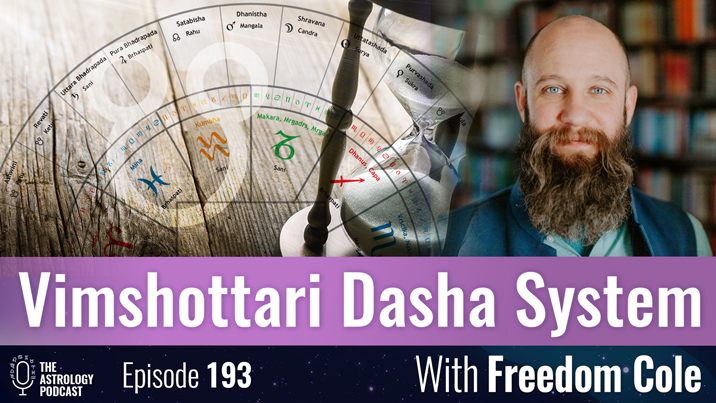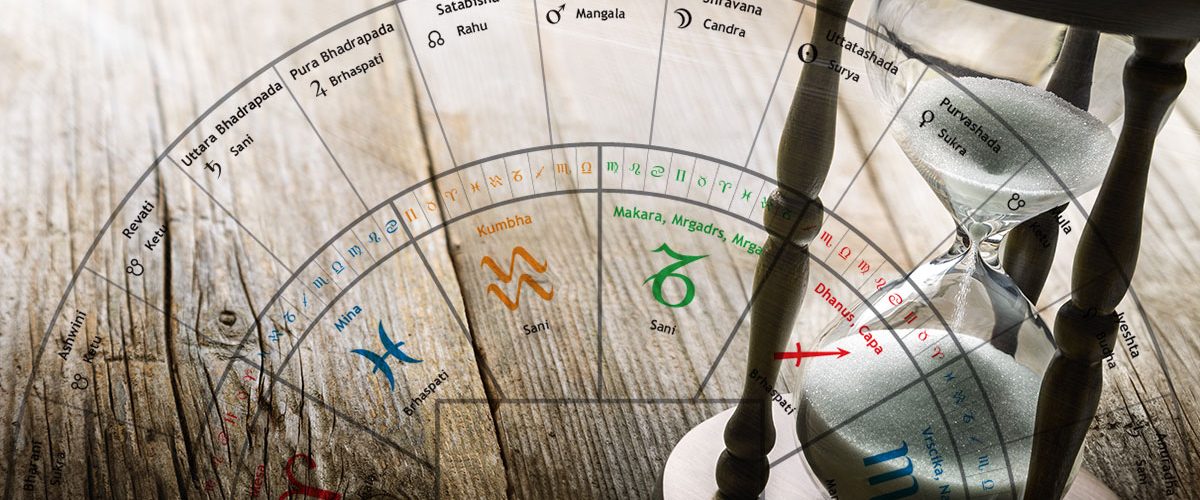
Episode 193 features an interview with astrologer Freedom Cole on the vimshottari dasha system, which is a timing technique used in Vedic astrology.
In the last episode of the podcast we presented an introduction to a recently recovered ancient time-lord technique called zodiacal releasing, and noted how a number of similar techniques called “dasha” systems are still used in Indian astrology to this day.
For this episode I decided to interview an expert in Vedic astrology in order to provide western astrologers with a well-rounded introduction to one of the most popular dasha techniques that is used today.
Freedom is the author of two books on Indian astrology: Science of Light: An Introduction to Vedic Astrology, and Science of Light, Volume 2: Foundations of Vedic Astrology.
He also teaches a course on Vedic astrology, and the next class begins on March 28, 2019. You can find more information on his website:
This episode is meant to be a general introduction to the calculation, conceptualization, and interpretation of the vimshottari dasha system. The outline is largely based on the chapter on dashas in volume 1 of Freedom’s book, although the book goes into more detail.
There is a long set of show notes below, which outline some of the main points touched on during the course of the episode.
This episode is available in both audio and video versions, and you will find links to both at the bottom of this page.
Vimshottari Dasha Podcast Outline
Here is an outline with some of the major points touched on in this episode:
Introduction
- Introducing Freedom, and talking about his background.
- Author of Science of Light (2 vols.)
- Follows the Parashara tradition primarily.
- Translated Sanskrit excerpts from Parashara in his book.
- Introduce the concept of dashas and timing (kalana).
- Understand the past, correctly perceive the present, and predict the future.
- The birth chart indicates various things.
- Dashas indicating when the indication will occur during the life.
- Not all chart placements are activated at all times.
- Many different dasha systems in Indian astrology.
- Three broad categories of dasha systems.
- Different dashas used for different purposes.
- The most common or popular is the vimshottari dasha system.
- First appears in Parashara (circa 8th century?).
Calculation
- How to calculate Vimshottari dasha periods, generally speaking.
- There is a new free online vimshottari dasha calculator on Astro-Seek.
- Was just launched today to coincide with this episode.
- Still in development. Report any bugs to the developer.
- Most programs for Windows like Solar Fire will calculate it; no good ones for Mac.
- The program Freedom recommends for Windows: http://www.vedicastrologer.org/jh/
- Astrodienst has a helpful guide for calculating vimshottari dasha periods, but sadly do not seem to offer chart calculation services for this technique on their site.
- The technique is calculated roughly as follows:
- Determine the nakshatra the Moon is located in at birth.
- The nakshatras are 27 lunar mansions, with 13°20′ degrees each.
- Note that these positions are sidereal.
- Each nakshatra is associated with a specific planet.
- Each planet rules a certain number of years:
- Ketu (south node) is 7 years
- Venus is 20 years
- Sun is 6 years
- Moon is 10 years
- Mars is 7 years
- Rahu (north node) is 18 years
- Jupiter is 16 years
- Saturn is 19 years
- Mercury is 17 years
- Whatever nakshatra the Moon is in, the ruling planet establishes first chapter of life.
- When that chapter is up, it moves to the ruler of the next nakshatra, in zodiacal order.
- Note that you must subtract a number of years proportional to how far through the first nakshatra the Moon is from the first period.
- This establishes the general periods, but there are also subperiods.
- General periods called dashas, subperiods called bhuktis.
- Or sometimes also called mahadashas and antra-dashas.
- Here is an example readout from Solar Fire, with George Lucas’ dashas on the right.
Interpreting Dashas and Bhuktis
- Once the planetary rulers are activated, how do we interpret them?
- Assuming we have a readout of our dashas and bhuktis, what do they mean?
- The condition of the planet in the natal chart is key.
- Quote from Parashara in Freedom’s book: “The dasha gives two particular types of results; that based on the planet’s intrinsic nature, and that based on the place of residence. Know the results of the dasha to manifest according to the nature of the planet’s strength.”
- Intrinsic nature
- What is the nature of the planet?
- What types of things does that planet normally signify?
- The natural characteristics of the planet will be more prevalent during its dasha
- Careful though: people sometimes get stuck on / focus too much on intrinsic nature.
- House placement
- How is the planet situated in the chart?
- What house is it placed in?
- The significations of the planet will be channeled through the house it is in.
- Strength or planetary condition
- The strength or condition of the lord will indicate favorable or unfavorable results.
- Is the planet auspiciously placed in the chart or inauspiciously placed?
- Some basic criteria for determining planetary condition in Vedic astrology:
- Being in its own sign versus being in an enemy’s sign.
- Being exalted versus being in its fall.
- Aspected by benefics vs. aspected by malefics.
- Being combust versus being free from the rays of the Sun.
- Being in a favorable house (esp. 1, 5, and 9) versus being in the 6th, 8th or 12th.
- Yogas
- Special rules for how malefics interact with benefics.
- House lordship
- The houses the dasha lord rules bring those topics into play.
- Relationship between general and subperiod lord placement
- General period lord and subperiod lord treated as if in conjunction
- Interaction of these two planets will flavor the results
- Transits
- Dasha will either support a transit or the opposite
–
Watch the Video Version of This Episode:
Here is the video version of this episode of the podcast:
–
Transcript
A full transcript of this episode is available: Episode 193 transcript
Listen to the Audio Version of This Episode:
You can either play this episode of the podcast directly from the website or download it as an MP3 to your computer by using the buttons below:
Podcast: Play in new window | Download (Duration: 1:51:20 — 76.8MB)


I look forward to listening to the whole episode soon- forgive the extremely Venus in Virgo comment, but the super valuable graphic created by Meredith has two minor typos that if corrected would make this beautiful contribution even more perfect: nakshatras Purva Bhadrapada and Uttarashada are misspelled. Thanks to all for this work of cooperative scholarship!
My friend Paula Belluomini just made a new version of the diagram for me, which fixes the typos you pointed out, as well as a few others: https://theastrologypodcast.com/wp-content/uploads/2019/02/nakshatras-02.jpg
Thank you both for this, utterly fascinating, About to get Freedoms books and take a serious look into this. As Chris has frequently said, the similiarities with Hellenistic timelord techniques are remarkable and there must be much to be learnt from the long and venerable Vedic tradition.
From a female PoV it does seem very “brother” dominated but I guess the only way that is going to change is if the sisters start doing it for themselves!
Jagannatha Hora is not “Freedom’s free program for Windows” (from the topic listing in this article). It is created and maintained by Narasimha Rao, a very prolific Vedic astrologer in his own right. The url (correctly) points to Narasimha Rao’s site , but the description implies Freedom Cole created it.
Thanks for pointing this out, I must have misunderstood something Freedom said when he recommended it to me when we were preparing for the episode, and I will correct this in the outline now.